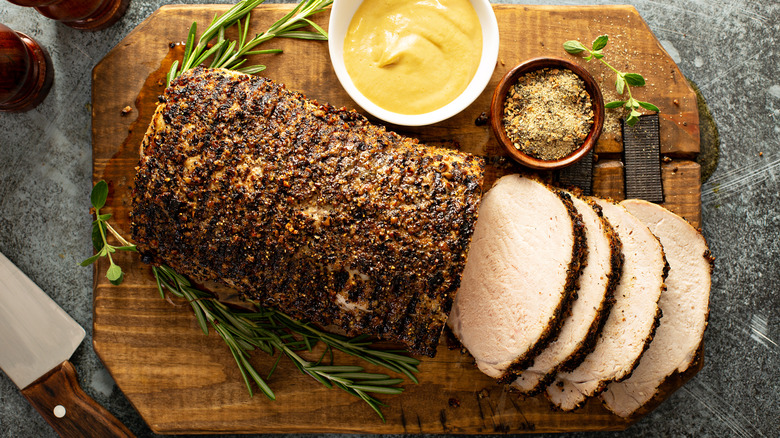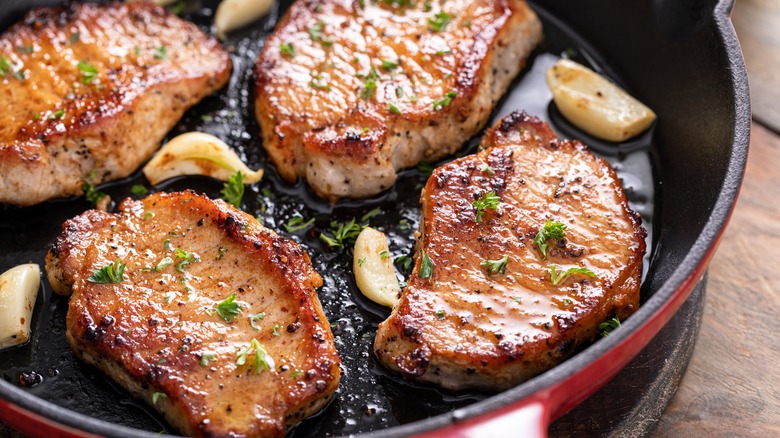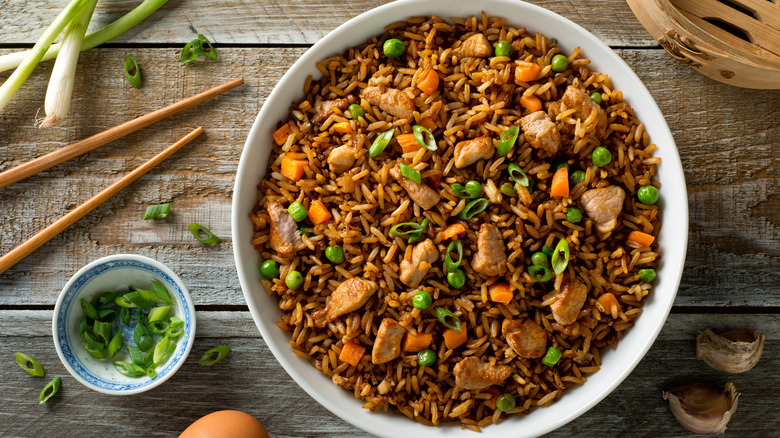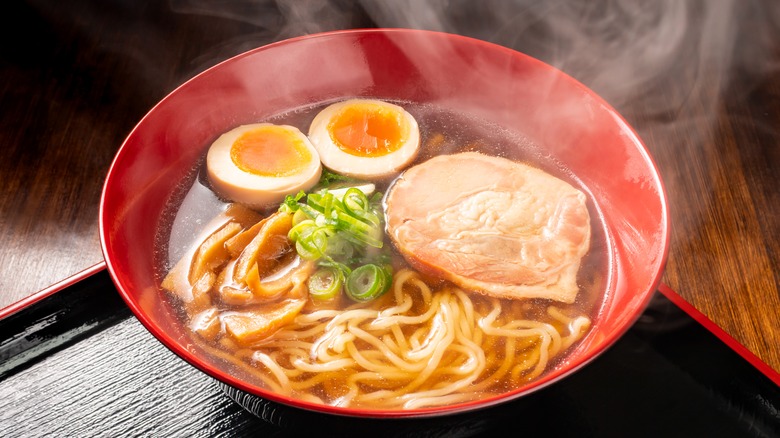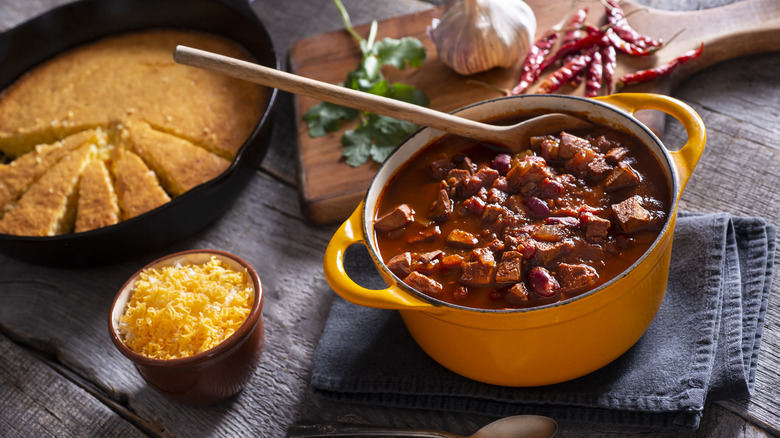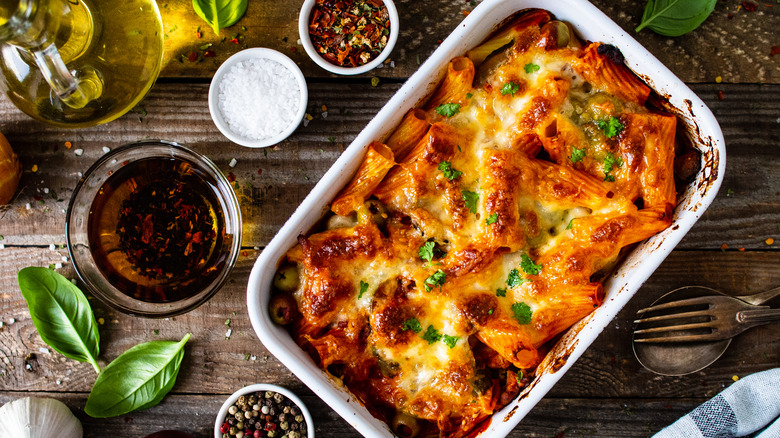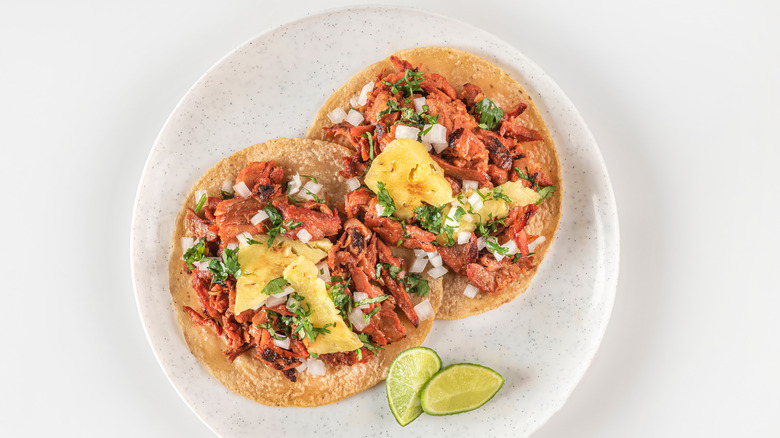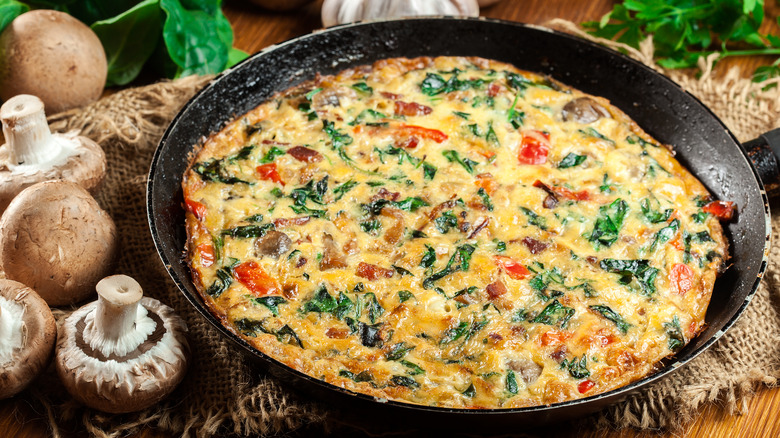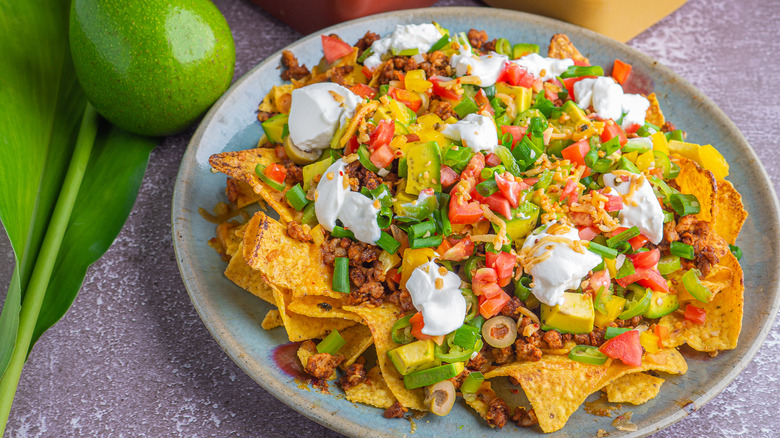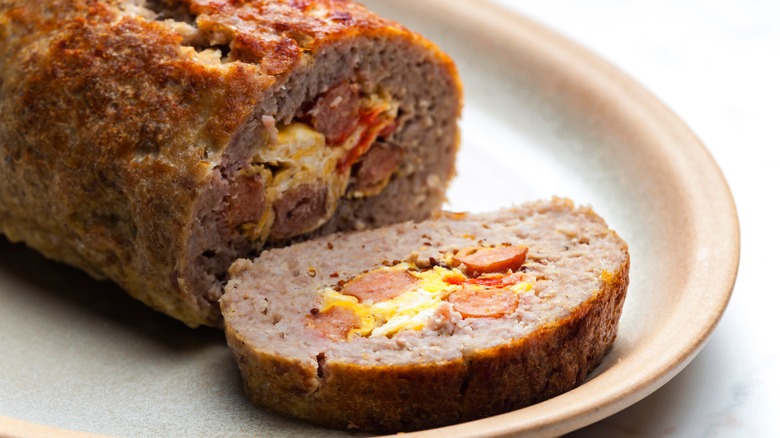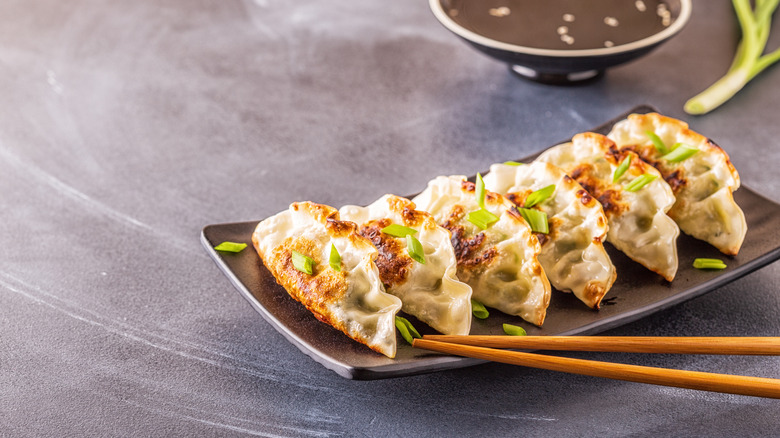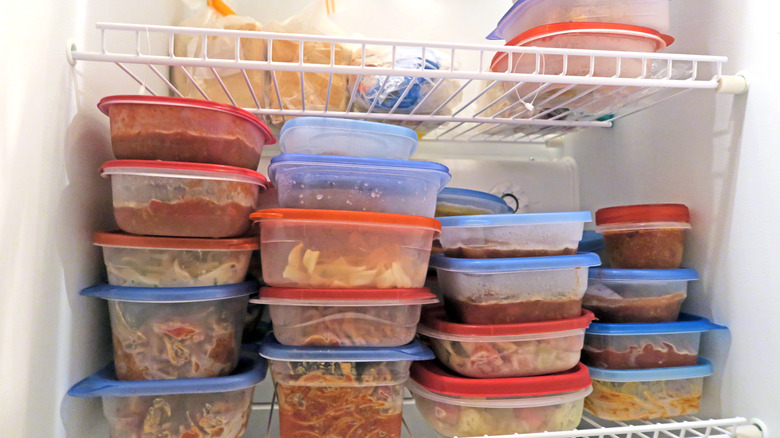What To Do With Leftover Pork Loin
Americans love pork, consuming 51.6 pounds of this meat per person annually, according to Statista. While bacon, sausage, and ham are delicious, I tend to favor a tender cut known as the loin. The loin is obtained from the stretch of the back extending from the shoulder to the upper leg. This muscle can be purchased bone-in or boneless, with or without the fat cap.
A whole pork loin typically weighs about 4 to 5 pounds. It can be purchased in smaller portions or cut into chops. It can serve approximately eight to ten people, making it a suitable option for entertaining. Pork loins can be grilled or roasted until a thermometer inserted into the center of the meat reaches a temperature of 145 degrees Fahrenheit. The resulting meat should be moist, juicy, and have a sweet flavor that lends itself to sauces of all kinds.
While a whole pork loin is an affordable and convenient way to feed many people, even with careful portioning, there are usually some leftovers. Figuring out how to use those leftovers has always been a source of angst in my restaurant. Waste is never an option. So I had to get creative, taking hints from how pork is cooked in myriad recipes across other cultures, as well as finding ways to substitute it for other meats in everyday recipes.
Simply reheat
No discussion about eating leftover pork loin would be complete without considering how to best reheat it without becoming tough and dry. The USDA suggests consuming cooked pork loin within three to four days of refrigeration. To safely consume leftover pork, it should be reheated to an internal temperature of 165 degrees Fahrenheit.
How you opt to reheat your pork loin may have as much to do with the size of the portion you plan to reheat as the method. It is best to reheat large portions in the oven with a portion of pork on a baking dish. Drizzle the top of the pork with a hint of olive oil and coat the bottom of the pan with water or chicken stock. Doing so will help create steam, keeping the pork moist as it reheats to a safe internal temperature, which should take approximately 25 to 30 minutes.
If you want to reheat slices of pork loin, using the stovetop is advisable. Coat the bottom of a skillet with olive oil for the pork and deglaze the pan with chicken stock or water. Once the liquid has begun to simmer, flip your meat over, cover it with a lid and allow the pork to simmer for just five minutes.
Rest it in rice
There is never a portion of leftover pork loin that doesn't transform easily into some iteration of a rice dish. Rice acts like a sponge for whatever flavors you add, making it the perfect vessel for resuscitating these leftovers. Fried rice is an easy way to transform the pork without using a lot of unnecessary dishes. This is also an opportunity to use up leftover vegetables along with the meat. Just be sure to add plenty of fresh garlic, ginger, toasted sesame oil, a hint of soy sauce, and some sriracha or gochujang to obtain that quintessential umami-rich flavor profile.
You can also add cubed chunks of pork loin to a classic paella or any other recipe for chicken and rice. Substitute the chicken with the pork, or consider using both for a more complex flavor. When making paella, never skimp on the saffron. It may be expensive, but its delicate floral essence gives paella its distinct taste. We recommend adding the cooked pork chunks when the rice is added to allow adequate time for the pork to reheat and absorb those Spanish flavors.
Slide it into soup or stew
Featuring pork in a soup or stew is not exactly a novel idea. Cultures across the globe use pork in recipes like Mexican pozole or French cassoulet. Few cultures are as fond of pork as those of Southeast Asia, in particular the Chinese. The lengthy history of pork consumption in China is even reflected in its language. Indeed, the Chinese character depicting the word for home or family consists of the symbol for the roof above the one for the pig.
While you can add leftover pork to any soup or stew recipe to make it more of a complete meal, some favorites include Chinese pork and cabbage soups, Japanese ramen or udon noodle dishes, and Taiwanese curries. The key is to give these soups and stews that slow-cooked depth of flavor without a lot of time. This is where condiments like miso, soy, and various fish sauces can come in handy. They can lend that complexity without a lot of time. Whatever you do, do not skimp on topping your noodle dishes with a soft-cooked or fried egg. The rich egg yolk coats the leftover pork like a luxurious cheese sauce.
Doctor up your chili
Pork and beans are a staple in American cuisine. A variation on ham and navy bean soup, Senate Bean Soup, has been on the menu daily in all eleven Congressional dining rooms since the early 20th century. Thus, adding leftover pork loin to your next batch of chili certainly makes sense.
While you could incorporate the pork into either a meat or bean chili, for the sake of not having competing textures, I would recommend adding it to the latter. That said, don't hesitate either way. The pork will absorb those smoky and spicy juices as they reheat in the chili liquid.
For added complexity, consider incorporating sweeter spices into your chili, like cinnamon, allspice, and cloves. The combination of sweet and pork is a match made in heaven. It will give your child an exotic flair that is quintessentially Mediterranean. Consider garnishing with a julienne of apple for a crunchy texture and to drive home that nostalgic, sweet, and savory flavor profile.
Class up your casserole
There is nothing more forgiving than a casserole for using up your leftover pork loin. These one-dish wonders are ideal for feeding a large family quickly and cost-effectively. The only limit to what you can do with leftover pork in a casserole is your creativity.
A formula for assembling a winning casserole is to start with your choice of meat, in this case, leftover chunks of pork loin. To this, you will need to add a canned creamed soup or a sauce you have made, like a leftover gravy or marinara. Next, select a vegetable or two of your choice and a carbohydrate, like rice or pasta, to round out your dish. Combine these ingredients before placing them in a greased baking dish.
Finish your casserole with cheese and a crispy topping, like French fried onions or potato chips. Bake the casserole in the oven until everything is hot and bubbly and the top is golden brown. All you need to round out this meal is a nice green salad, and dinner is served.
Slice it into sandwiches
Sandwiches are convenient and quick meals, but a plain ham sandwich gets old sometimes. Taking thin slices of roast pork loin and using them for a sandwich, like a Cuban or a Vietnamese banh mi, is a fabulous way to repurpose those leftovers and introduce excitement to your sandwich game.
The key to making the best sandwiches with pork loin is to layer contrasting textures and flavors that can appeal to all your tastes, including sweet, sour, salty, bitter, and umami. For a salty crunch, consider various pickled vegetables or relishes, like kimchi or coleslaw. For a tangy, spicy, umami kick, try making a creamy spread by combining sriracha and mayonnaise. To add a hint of sweetness, pop some honey into your spread.
And if you want to elevate your sandwich game, try using pork loin in a classic Monte Cristo. Combine the pork with gruyere cheese before dipping it in your egg batter and pan-frying it. Top with powdered sugar and apple butter for a play on the pork chops and applesauce theme.
Toss it into tacos
Pork tacos are a classic, simple variation to try. While you could certainly use your leftover pork loin as is, we recommend taking advantage of a little post-marinating action. Post-marinating is a process by which you allow cooked meat to tenderize and absorb additional flavor. Take your chunks of pork and submerge them in a marinade that is chock full of spices and acidity, like a classic Adobo sauce. Allow the pork to sit in your marinade for 15 minutes before sautéing it in a skillet over medium-high heat.
Once you have your pork reheated, layer the meat on fresh corn or flour tortillas that have been heated gently to make them pliable. If you are using corn tortillas, you might consider doubling them so that your tacos do not fall apart under the weight of any moist ingredients.
Next, start layering your tacos with a combination of various textural components. Try using fresh onions and cilantro, but you could also use a simple slaw made from tropical fruits like mango and pineapple. And finally, do not forget a hint of creaminess with some avocado or queso fresco.
Chop it into a salad
Stop by any small-town Midwestern deli, and you will find containers of pre-made pinkish-hued creamy ham salad for sale. The origin of this regional specialty comes from the necessity for frugality characteristic of other Depression-era recipes. Its popularity spread across the Midwest, Mid-Atlantic, and South, becoming a staple at funeral potlucks. This salad would be served between two slices of white bread or smeared onto crackers as a humble canapé.
While the classic takes advantage of leftover baked ham, there is no reason you couldn't use pork loin. As with ham, it is recommended that you chop your pork loin into different size pieces to help produce more of a contrast in texture. The classic iteration of this salad contained only three ingredients, including pickle relish and mayonnaise. Modern recipes often jazz up the classic with added ingredients like hard-boiled eggs, celery, onions, and mustard.
Because pork loin is not as salty as ham, we recommend amping up the flavor using spices like smoked paprika, garlic powder, and a hint of celery seed for kicks. You might also consider adding a hint of heat in the form of some hot sauce and a burst of umami flavor with some Worcestershire. Whatever you do, don't mess with the bread. Classic, spongy white bread is the optimal texture to absorb the flavors of this salad and enhance the sense of nostalgia while you eat it.
Envelope it in eggs
The go-to use for any leftovers is to turn it into a sunrise specialty. Pork loin is no exception to this rule. Ham or bacon may be the porcine delight typically used in breakfast dishes. Leftover pork loin makes for an elegant substitution for myriad recipes.
A majority of these breakfast dishes involved eggs in some permutation. For those who appreciate runny eggs, eggs Benedict is delicious. Thin slices of pork loin that have been pan-fried would be a lovely alternative to Canadian bacon in this classic.
For those preferring their eggs on the firmer side, a frittata or casserole is always a great choice. Toss your chopped leftover pork loin and assorted chopped vegetables into an egg batter. Pour these into a greased oven-safe skillet or baking dish and top with shredded cheese. Bake until your eggs are set, and you have a dish that will turn even those who aren't morning people into happy campers.
Finally, consider a variation on a classic corned beef hash. Sauté the onions, potatoes, and garlic in butter as usual. Add chopped pork loin and seasonings, and finish your dish with eggs. It may not be authentic, but sometimes, it is fun to change things up in the kitchen.
Pop it onto pizza
You had to know putting leftover pork loin onto a pizza would eventually come up. Pizza makes everything better, including pork. The idea isn't as out there as it might sound. If you enjoy a Hawaiian pizza, try substituting the Canadian bacon with slices or chunks of pork loin before adding your pineapple and baking your pie. For those craving an extra burst of umami flavor on that Hawaiian pie, try adding some chopped olives or mushrooms to round things out.
Another pizza that could easily benefit from leftover pork loin is a barbecue pie. Most barbecue pizza is made with chicken, but there is no reason you couldn't use pork. The sweet and spicy notes characteristic of a classic smoky barbecue sauce are the perfect complement to pork. All you will need to do is swap out the chicken with the chunks of pork loin in your favorite recipe and finish your pie as usual. If you are feeling cheeky, you can use both chicken and pork.
Nestle it in nachos
Nachos themselves were an accidental invention that took advantage of leftover ingredients on hand. They allegedly came about in 1940 when a clever maître d'hôtel named Ignacio Anaya was the only one working the day shift at Victory Club restaurant in Piedra Negras, Mexico. He was surprised when women from the military base across the Rio Grande stopped by looking for a meal during off hours. With no chef and limited ingredients, he took tortilla chips, cheese, and jalapenos, threw them together, and broiled the combination until the cheese melted and the nacho was born.
Today, nachos are often a vessel for leftover ingredients of all kinds. The more ingredients, the merrier, with nacho boards similar to charcuterie platters becoming a pop culture phenomenon of late. It makes sense that leftover pork loin should be repurposed as one such topping on a nacho supreme of epic porky proportions. Cut your pork loin into chunks, add it atop your chips with your favorite ingredients, like beans and avocado, add your cheese, and pop the whole thing under the broiler until melted and golden.
Stuff it in a meatloaf
If you didn't already know, stuffed meatloaf is a thing, and you will want to make one using some of your leftover pork loin. It is not as complicated as it may sound. There are endless variations of stuffed meatloaf, including classics like those filled with hard-boiled eggs or cheese and ones that are more of a carbohydrate lovers feast, like mashed potato and macaroni and cheese varieties.
Several include a combination of spinach, mushrooms, ham, and cheese. With these, we recommend swapping the ham out with chopped pork loin. The sautéed spinach and mushrooms will help keep the center of your meatloaf moist, while the pork loin and cheese will confer fat and flavor. It is a match made in piggy heaven. And if you want to use those carbs, there is no reason you could not add some chopped pork loin chunks with that macaroni and cheese or mashed potato filling. Once you have the basic technique mastered, the sky is the limit in terms of ways you could stuff your loaf.
Dump it in dumplings
Dumplings are as varied as the cultures they come from. There are Chinese dumplings you'd see in a Dim Sum restaurant, Japanese gyoza, and even Polish pierogies. The primary difference between these is the type of dough used to wrap the dumplings. And if you are being loose with the definition of a dumpling, you could even say Italian ravioli is a type of dumpling.
There is no reason you couldn't stuff any one of these recipes with leftover pork loin combined with the appropriate ingredients that make each of these unique. The key will be in the aromatics, spices, and condiments you use to assemble your filling. And because you don't need to cook the pork, these ingredients will come together quickly.
The most labor-intensive part of their assembly will be stuffing your dough and cooking your dumplings. The result will be even more complex thanks to the richness of the flavors in the leftover pork combined with those added to the filling.
Freeze it
If you still don't think you can use up all of your leftover pork loin in three or four days, you should probably freeze it. You'll be glad you did. Nothing is better than having portions of frozen pork loin in your freezer for a rainy day when you don't feel like going out and finding ingredients to whip up dinner. The key is to know how to freeze your pork loin to preserve its flavor and texture.
The first step is to ensure your pork loin is completely cooled before you wrap it tightly in foil or freezer paper. Once you have done this, place your pork into an airtight container, like a Ziploc freezer bag. Always write the date on the bag to ensure you use it in time. For best quality, use your frozen pork within three to four months, as recommended by the USDA. It is recommended that you place your pork in the back of the freezer, away from the door, to prevent drastic temperature changes that may encourage the formation of freezer burn on your meat. To thaw your pork, place it into the refrigerator overnight for the best results.
